The GeForce GTX 770 Roundup: EVGA, Gigabyte, and MSI Compared
by Ryan Smith on October 4, 2013 9:00 AM ESTPower, Temperature, & Noise
Having seen the gaming performance of these cards and the limited gains from their factory overclocks, let’s move on to power, temperature, and noise. If these cards are going to differentiate themselves it needs to be accomplished by factors the manufacturers have more control over, and their respective coolers are a good way to do it.
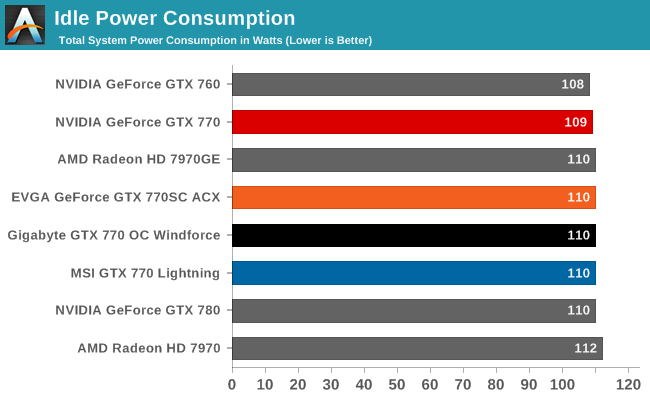
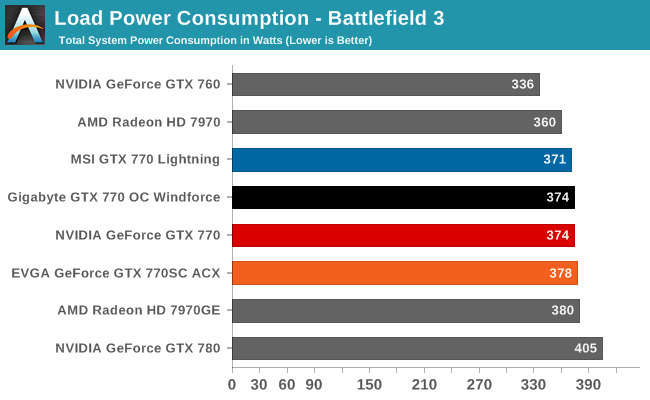
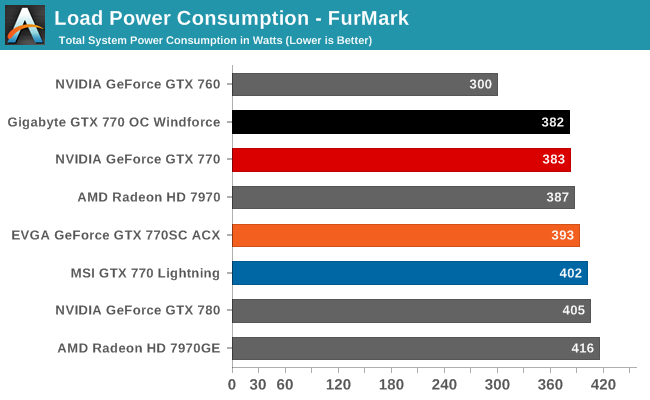
With our cards spanning the full spread of possibilities – semi-custom, custom, and custom with heavily modified power delivery – even load power consumption starts separating the cards to at least a small degree. Although it’s just a minor difference, MSI’s GTX 770 Lightning has the lowest power consumption of the three in Battlefield 3, beating every GTX 770, including the lower clocked stock GTX 770, by at least a few watts. Since we are memory bandwidth limited in BF3, and thereby performance limited, for better or worse these cards can’t get too far from each other. But for a few watts difference we’re in all likelihood looking at general chip-to-chip variation rather than some intrinsic advantage in any one card, even with the use of custom components.
FurMark on the other hand shows some larger differences, but as this is our stress test what we’re really seeing is the difference in the cards’ regulated TDP. MSI’s 260W TDP means they have a larger power budget to work with, draw more power, and don’t get throttled quite as hard as the other cards. The end result being that FurMark is not particularly useful in comparing cards in this case. Otherwise the difference between the EVGA and Gigabyte cards is larger than we’d expect even with chip to chip variation, which may mean Gigabyte’s Ultra Durable component selection has some impact under maximal workloads.
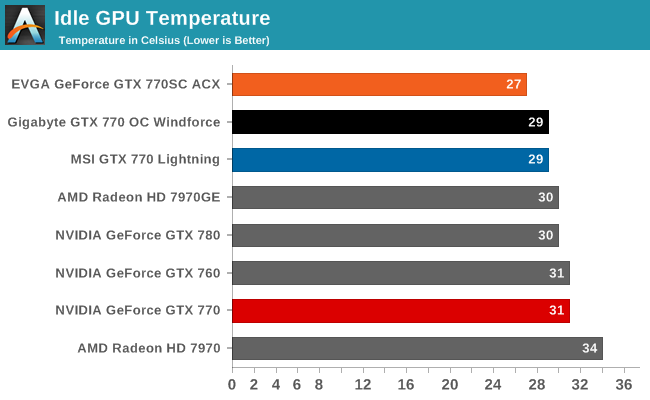
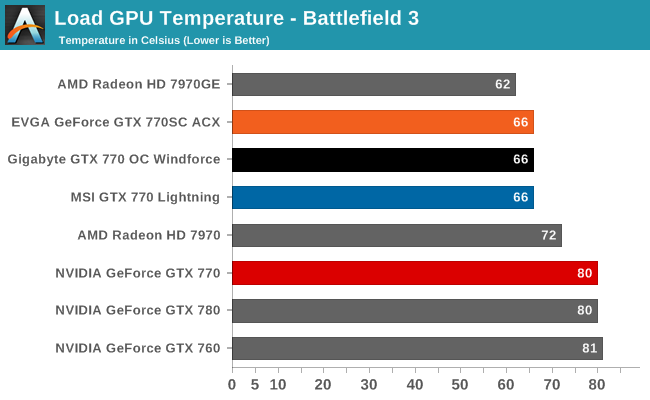
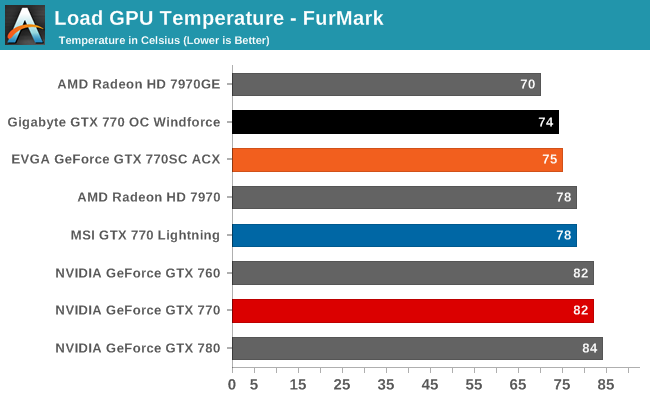
Moving on to temperatures, despite the difference in both the number of fans and the size of said fans, the end result has all of our cards perfectly tied under BF3. Every card tops out at 66C, EVGA, MSI, and Gigabyte alike. Open air coolers as a general design are difficult to improve on, so despite everyone’s efforts, unless someone uses a wildly different fan curve than the others then any well designed open air cooler should perform similar. Notably, because every card tops out at 66C, they’re all well below the thermal throttle point on the GTX 770 of 80C. This means no card ever throttles, which can be useful for squeezing out a little more performance out of what’s otherwise the same GPU.
Meanwhile FurMark temperatures are less than useful here for the same reasons as power. Gigabyte and EVGA top out at 74C and 75C here respectively, while the higher TDP MSI card tops out at 78C. Though this does go to show that even in our stress test none of these cards reaches the 80C throttle point.
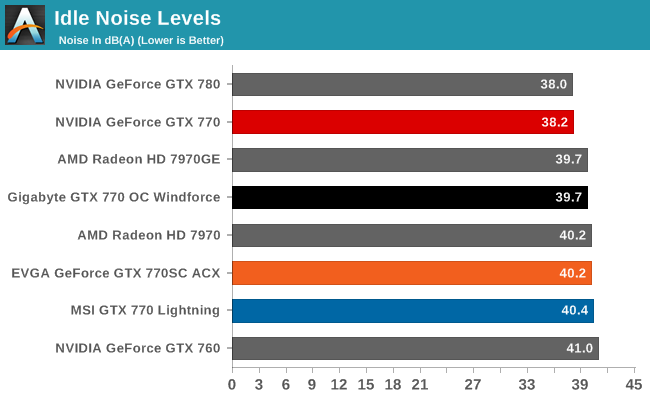
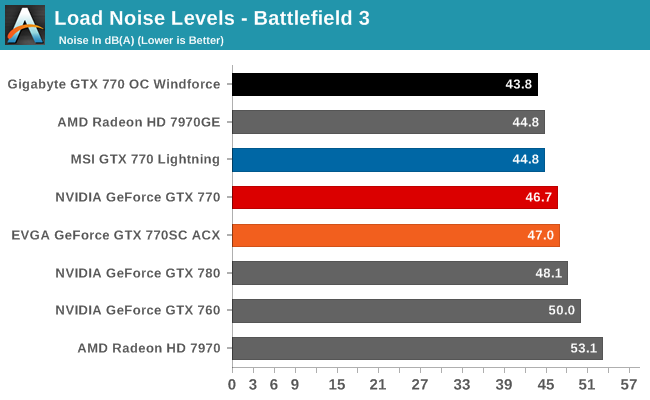

Finally looking at our noise results, we find that unlike our performance data there’s some clear and meaningful separation between the cards, especially between the EVGA card and the remaining two cards. For whatever reason the EVGA card hits 47dB under BF3, a hair louder than even the blower based reference GTX 770. Admittedly the Titan cooler on the reference GTX 770 is overbuilt for a card of this configuration, and as such over performs and is by no means easy to catch, but it does mean that EVGA isn’t gaining anything over the blower from a noise perspective. It’s no worse, it’s just not any better, which indicates that EVGA’s ACX cooler may not be scaling down very well.
MSI and Gigabyte on the other hand manage to beat EVGA and the reference GTX 770 by 2-3dB, a small but not insignificant amount. The winner here is Gigabyte at 43.8dB under BF3, followed by MSI at 44.8dB. These noise levels aren’t going to be silent, but they’re also not too far off of it. For the level of performance these cards offer it’s a fairly impressive outcome, albeit the typical one for the open air cooler tradeoff.
Speaking of silence, when it comes to idle noise every card is actually a bit worse than the reference GTX 770 here, owing to NVIDIA’s single fan and use of materials. The roughly 40dB results aren’t by any means bad, but they aren’t going to get as close to being silent as NVIDIA’s reference blower.
In summary, differences in TDP aside all three cards are solid, similar performers when it comes to temperature and power consumption. However when it comes to noise under load, both Gigabyte and MSI have an edge here over EVGA and the reference GTX 770, which for stock performance does give these cards a small but meaningful lead over the competition. Gigabyte is the best performer in this respect, although MSI is right behind them. At the same time however this means that despite the difference in the designs of their coolers – 3 smaller and 2 larger fans respectively – it isn’t creating a practical difference between the Gigabyte and MSI cards.










55 Comments
View All Comments
MarcHFR - Saturday, October 5, 2013 - link
Hi RyanTwo question
- 38 dBA is very high for idle. What's the measuring distance ? Background noise with computer off ? Noise of the computer with fanless graphic card ?
- What are the model of 7970 and 7970 GHz tested ?
Thans a lot !
Ryan Smith - Saturday, October 5, 2013 - link
1) It's fairly close; under a foot. The idea isn't so much to measure absolute noise as to compare and rank cards.2) Reference 7970. HIS IceQ X2 7970 GHz Edition.
MarcHFR - Sunday, October 6, 2013 - link
Thanks, so less than one foot from the closed Thermaltake Speedo, that's it ?And what about background and computer (without active graphic card) noise ? What is the sound-level meter used ? Thanks
PC Perv - Saturday, October 5, 2013 - link
It is interesting to see how far the custom cooling solutions (and custom PCBs) have come on video cards. I know it is nothing new and obviously marketing-driven, but nevertheless gives consumers more choices and better experiences.Thank you for thorough review, Ryan.
PC Perv - Saturday, October 5, 2013 - link
Even betweein the same OEM's cooler's, I see how they "evolved." For instance, Gigabyte's WindForce had quite a few shortcomings at first - no heatsinks on memory/VRMs, fan rattling and getting worse over time, etc. It's great to see that they are learning and improving.Slomo4shO - Sunday, October 6, 2013 - link
I would love to see an expansion to the OC section of these reviews and having OC figures for the comparison cards as well (760, 780, 7970, and 7970GE). Can you or whoever is writing up the review the upcoming R9 280X also include the OC benchmarks of the 770s in the overclock section of that review?marraco - Sunday, October 6, 2013 - link
Something that would be very useful and valuable for differentiation purposes would be a card easy to clean. All of my cards get his radiators completely occluded with dust from time to time, and cleaning them is incredibely annoying.I wish it could be as easy as trowing the radiator and fans to the dishwasher. But it never is as simple. I don't dare to wet my fans, because they are not detachable from the engines. And removing the radiator mean having silicone paste to reinstall them. Frequently I don't ever have silicone paste. I need to buy more, and that's a delay, and an impediment to clean the cards at convenient times.
Same goes for CPU and power refrigeration systems.
ShieTar - Monday, October 7, 2013 - link
Is there any chance to add an SLI of 2x GTX 760 to this round of benchmarks? This option costs less than a GTX780, but has the potential of out-performing a Titan. Therefore it would be very interesting to see how it performs in reality.The Warden - Sunday, November 3, 2013 - link
Ryan, can you tell me if this GTX 770 would be a good choice to replace my very old ATI Radeon HD 2600 XT for the specific purpose of improving my Final Cut Pro editing processes? I just don't know if the graphics cards play that big a roll in the editing displays and playback for Final Cut, and if I am just fine with what I have.Chloiber - Thursday, November 21, 2013 - link
I'm really disappointed by the EVGA card. I currently own a 770 SC ACX. It's loud in idle (fan won't go below 1400rpm), it's pretty loud under load. Why do I even buy a custom card? For the 50MHz higher boost?They clearly forgot what a custom card is all about. You can get a silent BIOS from the support which reduces the idle fan speed to 1100rpm. Still way too loud for my taste.
Same goes for the ASUS DC2OC by the way. It's quieter in idle, but fans won't go below 1100rpm.